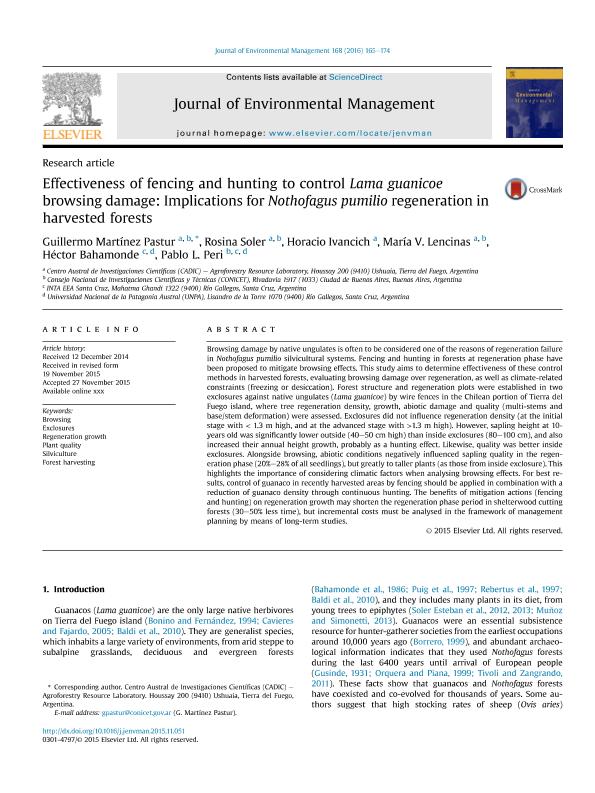Mostrar el registro sencillo del ítem
dc.contributor.author
Martínez Pastur, Guillermo José

dc.contributor.author
Soler Esteban, Rosina Matilde

dc.contributor.author
Ivancich, Horacio Simón

dc.contributor.author
Lencinas, María Vanessa

dc.contributor.author
Bahamonde, Héctor Alejandro

dc.contributor.author
Peri, Pablo Luis

dc.date.available
2018-04-27T19:38:49Z
dc.date.issued
2016-03
dc.identifier.citation
Martínez Pastur, Guillermo José; Soler Esteban, Rosina Matilde; Ivancich, Horacio Simón; Lencinas, María Vanessa; Bahamonde, Héctor Alejandro; et al.; Effectiveness of fencing and hunting to control Lama guanicoe browsing damage: Implications for Nothofagus pumilio regeneration in harvested forests; Academic Press Ltd - Elsevier Science Ltd; Journal of Environmental Management; 168; 3-2016; 165-174
dc.identifier.issn
0301-4797
dc.identifier.uri
http://hdl.handle.net/11336/43736
dc.description.abstract
Browsing damage by native ungulates is often to be considered one of the reasons of regeneration failure in Nothofagus pumilio silvicultural systems. Fencing and hunting in forests at regeneration phase have been proposed to mitigate browsing effects. This study aims to determine effectiveness of these control methods in harvested forests, evaluating browsing damage over regeneration, as well as climate-related constraints (freezing or desiccation). Forest structure and regeneration plots were established in two exclosures against native ungulates (Lama guanicoe) by wire fences in the Chilean portion of Tierra del Fuego island, where tree regeneration density, growth, abiotic damage and quality (multi-stems and base/stem deformation) were assessed. Exclosures did not influence regeneration density (at the initial stage with < 1.3 m high, and at the advanced stage with >1.3 m high). However, sapling height at 10-years old was significantly lower outside (40–50 cm high) than inside exclosures (80–100 cm), and also increased their annual height growth, probably as a hunting effect. Likewise, quality was better inside exclosures. Alongside browsing, abiotic conditions negatively influenced sapling quality in the regeneration phase (20%–28% of all seedlings), but greatly to taller plants (as those from inside exclosure). This highlights the importance of considering climatic factors when analysing browsing effects. For best results, control of guanaco in recently harvested areas by fencing should be applied in combination with a reduction of guanaco density through continuous hunting. The benefits of mitigation actions (fencing and hunting) on regeneration growth may shorten the regeneration phase period in shelterwood cutting forests (30–50% less time), but incremental costs must be analysed in the framework of management planning by means of long-term studies.
dc.format
application/pdf
dc.language.iso
eng
dc.publisher
Academic Press Ltd - Elsevier Science Ltd

dc.rights
info:eu-repo/semantics/openAccess
dc.rights.uri
https://creativecommons.org/licenses/by-nc-sa/2.5/ar/
dc.subject
Browsing
dc.subject
Exclosures
dc.subject
Regeneration Growth
dc.subject
Plant Quality
dc.subject
Silviculture
dc.subject
Forest Harvesting
dc.subject.classification
Meteorología y Ciencias Atmosféricas

dc.subject.classification
Ciencias de la Tierra y relacionadas con el Medio Ambiente

dc.subject.classification
CIENCIAS NATURALES Y EXACTAS

dc.title
Effectiveness of fencing and hunting to control Lama guanicoe browsing damage: Implications for Nothofagus pumilio regeneration in harvested forests
dc.type
info:eu-repo/semantics/article
dc.type
info:ar-repo/semantics/artículo
dc.type
info:eu-repo/semantics/publishedVersion
dc.date.updated
2018-04-27T14:00:21Z
dc.journal.volume
168
dc.journal.pagination
165-174
dc.journal.pais
Estados Unidos

dc.journal.ciudad
New York
dc.description.fil
Fil: Martínez Pastur, Guillermo José. Consejo Nacional de Investigaciones Científicas y Técnicas. Centro Austral de Investigaciones Científicas; Argentina
dc.description.fil
Fil: Soler Esteban, Rosina Matilde. Consejo Nacional de Investigaciones Científicas y Técnicas. Centro Austral de Investigaciones Científicas; Argentina
dc.description.fil
Fil: Ivancich, Horacio Simón. Consejo Nacional de Investigaciones Científicas y Técnicas. Centro Austral de Investigaciones Científicas; Argentina
dc.description.fil
Fil: Lencinas, María Vanessa. Consejo Nacional de Investigaciones Científicas y Técnicas. Centro Austral de Investigaciones Científicas; Argentina
dc.description.fil
Fil: Bahamonde, Héctor Alejandro. Instituto Nacional de Tecnología Agropecuaria; Argentina. Universidad Nacional de la Patagonia Austral; Argentina
dc.description.fil
Fil: Peri, Pablo Luis. Consejo Nacional de Investigaciones Científicas y Técnicas; Argentina. Instituto Nacional de Tecnología Agropecuaria; Argentina. Universidad Nacional de la Patagonia Austral; Argentina
dc.journal.title
Journal of Environmental Management

dc.relation.alternativeid
info:eu-repo/semantics/altIdentifier/doi/http://dx.doi.org/10.1016/j.jenvman.2015.11.051
dc.relation.alternativeid
info:eu-repo/semantics/altIdentifier/url/https://www.sciencedirect.com/science/article/pii/S0301479715304059
Archivos asociados
